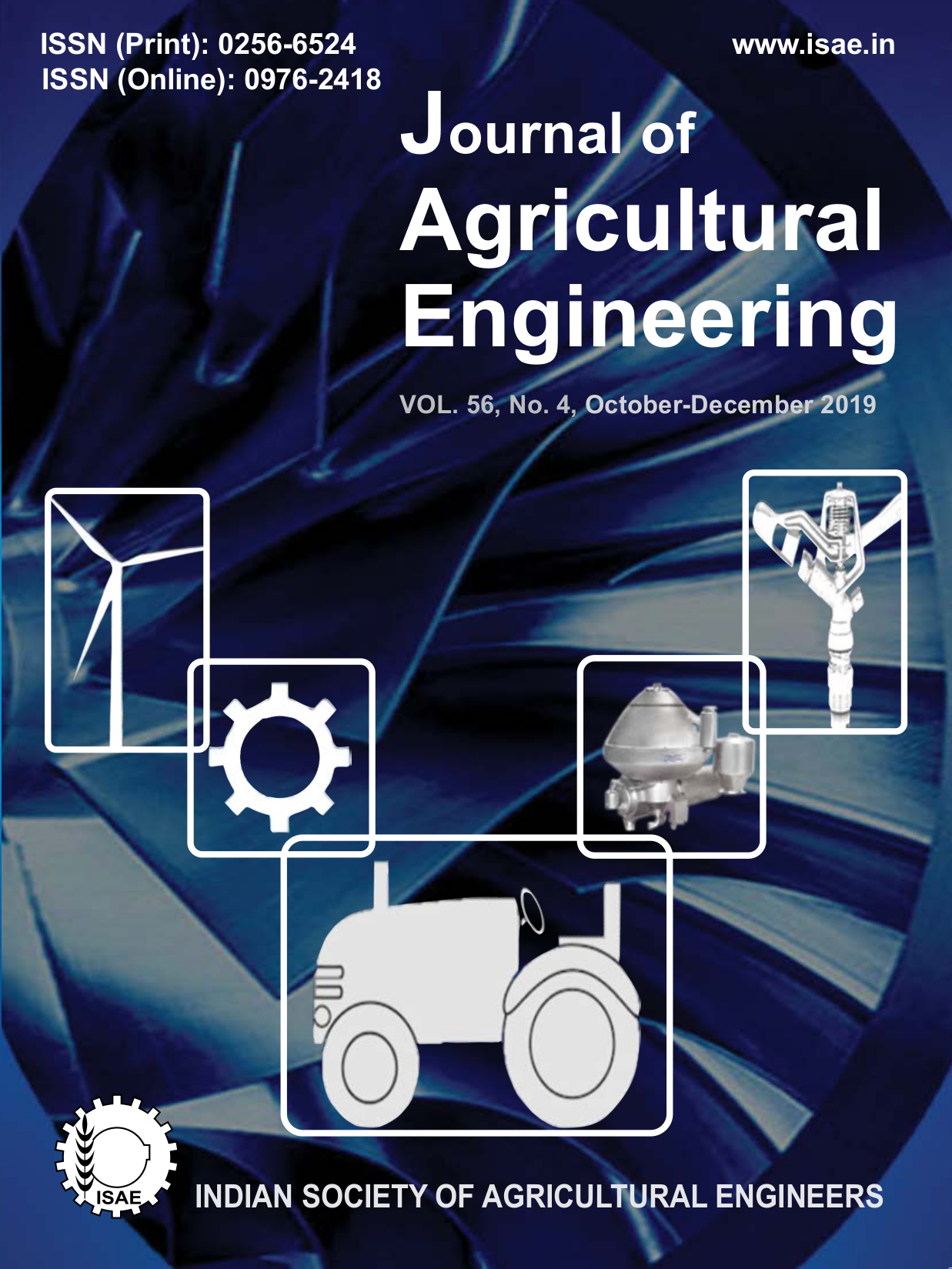Evaluating Efficacy of Recharge Structures in Augmenting Groundwater Resources in Muzaffarnagar, Uttar Pradesh
DOI:
https://doi.org/10.52151/jae2019564.1696Keywords:
Recharge structure, radial filter, pond, recharge rateAbstract
Groundwater play a vital role in stabilizing Indian agriculture, but its indiscriminate uses is resulting in fast depletion and degradation of this key natural resource. Sustainable groundwater resource management is, therefore, a priority issue before the country. Enhancing artificial groundwater recharge by adopting suitable technological interventions can be an option. Two cavity-type recharge structures with radial-1 filter were designed-1 and installed with village ponds at Kutba and Nirmana villages, and their impact on groundwater was assessed. Recharge rates varied from 382 m3 .day-1 to 906 m3 .day-1 during three test cycles, each of 8 days duration. As estimated, 27,304 m3 surplus water was recharged through the recharge well at Kutba site during December 2017 to March 2018. Similarly, 0.2 m water table rise was recorded beneath and around the structure at Nirmana during monsoon 2018. Results of field investigations revealed that cavity-type recharge structure in combination with a pond and radial filter can be a good option for recharging surplus canal and rainwater for augmentation of water resources in groundwater depleting areas.
References
CGWB. 2013. Dynamic Groundwater Resources of India. Report of the Central Ground Water Board (CGWB), Ministry of Water Resources, New Delhi, India, pp: 308.
CGWB. 2017. Ground Water Year Book- India, 2016- 17. http://cgwb.gov.in/Ground-Water/Groundwater%20Year%20Book%202016-17.pdf (accessed on13 June, 2019).
Chadha D K. 2002. State of art of artificial recharge applied on village level scheme in India. In: Report, Management of Aquifer Recharge and Subsurface Storage: Making Better Use of Our Largest Reservoir. (Eds. Tuinhof A; Heederik J P), Netherlands National Committee –Intl. Assoc. Hydrogeologists NNC-IAH Publication No 4, 19-24.
FAO. 2003. Estimates of Water Requirements, Chapter 2. Manual on Water for Freshwater Fish Culture, Volume 4, FAO Training Series: Simple Methods for Aquaculture, Version-I. CD ROM/DVD, Food and Agriculture Organization (FAO), Rome.
Kaledhonkar M J; Singh O P; Ambast S K; Tyagi N K; Tyagi K C. 2003. Artificial groundwater recharge through recharge tube wells: A case study. Inst. Eng. (I) J. (AG), 84, 28-32.
Kamra S K. 2010. Recharge and skimming: Opportunities and technologies for poor quality groundwater areas. In: Compendium (Eds. Yadav R K; Meena R L; Jat H S; Singh R K; Lal K; Gupta S K), Use of Poor Quality Water in Agriculture, Central Soil Salinity Research Institute, Karnal, India, 134-143.
Kamra S K. 2013. Role of farmers’ participation for effective management of groundwater recharge structures in Haryana. In: Proc. Workshop on ‘Roadmap for Sustainable Groundwater Resources in Punjab and Haryana’ organized by CGWB North West Region, Chandigarh India, February 27, 88-99.
Kumar S; Kamra S K; Yadav R K; Sharma J P. 2012. Evaluation of sand-based storm water filtration system for groundwater recharge wells. Curr. Sci., 103(4), 395-404.
Kumar S; Kamra S K; Yadav R K; Narjary B. 2014. Effectiveness of horizontal filter for artificial groundwater recharge structure. J. Agric. Eng., 51(3), 24 - 33.
Miller W P; Miller D M. 1987. A micro-pipette method for soil mechanical analysis. Communications in Soil Sci. and Plant Analy., 18(1), 1-15.
Pandey H. 2005. Hydraulic analysis of cavity well during pumping and recharge. Unpublished M. Tech. Thesis submitted to MPUAT, Udaipur, Rajasthan), pp: 104.
Sharma H. 2014. Evaluation of groundwater depletion scenario and its impacts in NW India by geodetic techniques & modelling approaches. Unpublished M. Tech. Thesis submitted to Andhra University, Visakhapatnam. Assessed on 14 May, 2019. https://www.iirs.gov.in/iirs/sites/.../StudentThesis/Hemanti_Sharma_mtech_2012-14.pp.
Suhag R. 2016. Overview of Ground Water in India, PRS. http://www.prsindia.org/administrator/uploads/general/1455682937 ~~ Over view of Ground Water in India. pdf. (assessed on 10 June, 2019).
WHO. 2011. Guidelines for drinking water quality. IVEd., World Health Organization’s (WHO), Geneva, Switzerland, pp: 564














